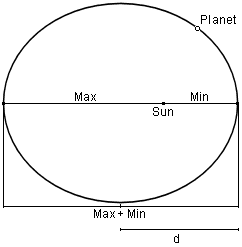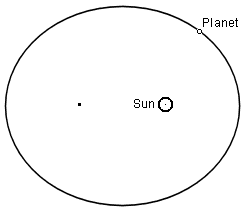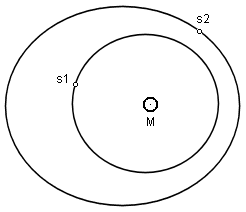Kepler's Laws of Planetary Motion
Kepler defined three basic laws of planetary motion.


Max = Maximum distance from sun
Min = Minimum distance from sun
Mean = Mean distance from sun
= (Max + Min) / 2
= d
-
The Law of Orbits
All planetary orbital planes are elliptical with the sun at one of the two foci.

- The Law of Equal Areas
The radius vector between the sun and a planet sweeps out equal areas in equal times on the elliptical orbital plane.

- The Law of Orbital Periods
The square of the ratio of the orbital time periods of two planets is proportional to the cube of the ratio of their mean orbital distances (or semi-major axes) of their orbits.
In the form of an equation, Kepler's third law may be expressed as:

Physical interpretation:
If it takes time (t1) for satellite 1 (s1) to orbit mass (M) at mean distance (d1), then it would take time (t2) for satellite 2 (s2) to orbit the same mass at mean distance (d2). The mean distance here is the same as the semi-major axis of the orbit.

The orbital time period (t) can be in any convenient units. The mean orbital distance (d) can also be in any convenient units.
Here, the mean orbital distance refers to the mean distance taken over the eccentric anomaly of the orbit, which equates to the semi-major axis, or1/2the major (longer) axis of the orbital ellipse plane.
HyperPhysics-Ref: (tries to open in a new tab)
http://hyperphysics.phy-astr.gsu.edu/hbase/kepler.html
Wiki-Ref: (tries to open in a new tab)
http://en.wikipedia.org/wiki/Kepler's_laws_of_planetary_motion
Jay Tanner - 2012 - PHP Science Labs